Think your kitchen adventures are limited to the same old flavors? Think again! Dive into the vibrant world of Indian cuisine with our roundup of 18 Delicious Easy Indian Recipes Spicy. Perfect for home cooks in North America looking to spice up their meal routine, these dishes promise a feast of flavors that are as easy to make as they are irresistible. Ready to transform your dinner table? Let's get cooking!
Butter Chicken
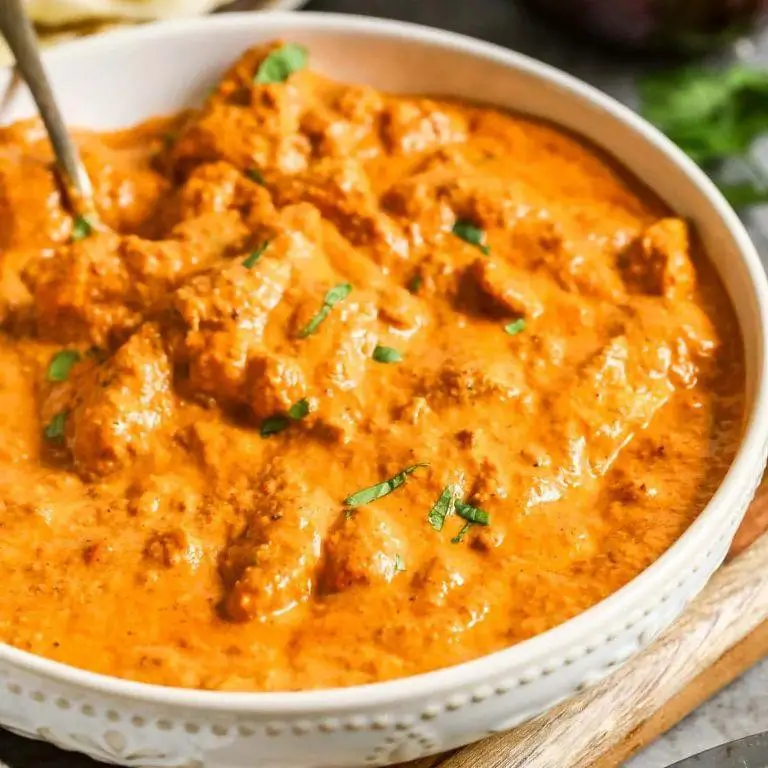
Kneading through the memories of my travels, I often find myself drawn back to the aromatic lanes of India, where the scent of butter chicken wafts through the air, a dish that’s as comforting as it is vibrant.
Ingredients
- 2 lbs chicken thighs, bone-in and skin-on (for that deep flavor)
- 1 cup full-fat yogurt (Greek works wonders here)
- 2 tbsp lemon juice (freshly squeezed, it makes all the difference)
- 4 tbsp unsalted butter (I always reach for the good stuff)
- 1 large onion, finely diced (yellow onions are my preference)
- 3 garlic cloves, minced (the more, the merrier in my book)
- 1 tbsp ginger, grated (keep a knob in the freezer for easy grating)
- 1 can (14 oz) tomato sauce (San Marzano tomatoes are my secret weapon)
- 1 cup heavy cream (for that luxurious texture)
- 1 tbsp garam masala (toast it lightly to awaken the spices)
- 1 tsp turmeric (a little goes a long way)
- 1 tsp cayenne pepper (adjust to your heat preference)
- Salt to taste (I like to use Himalayan pink salt for its subtle minerality)
Instructions
- In a large bowl, combine the chicken thighs, yogurt, lemon juice, and a pinch of salt. Cover and marinate in the refrigerator for at least 4 hours, preferably overnight.
- Melt 2 tbsp of butter in a large skillet over medium heat. Add the chicken thighs, skin side down, and cook until golden brown, about 5 minutes per side. Remove and set aside.
- In the same skillet, add the remaining butter, onion, garlic, and ginger. Sauté until the onions are translucent, about 5 minutes.
- Stir in the tomato sauce, garam masala, turmeric, and cayenne pepper. Cook for 5 minutes, allowing the flavors to meld.
- Return the chicken to the skillet, spooning the sauce over the thighs. Cover and simmer on low heat for 30 minutes.
- Remove the lid, stir in the heavy cream, and simmer for an additional 10 minutes until the sauce thickens slightly.
- Season with salt to taste, and let it rest for 5 minutes before serving.
Just as the sun sets, casting golden hues, this butter chicken emerges with its velvety sauce clinging to tender pieces of chicken, a dish that invites you to savor each bite slowly, perhaps with a side of fluffy basmati rice or warm naan to scoop up every last drop.
Chana Masala
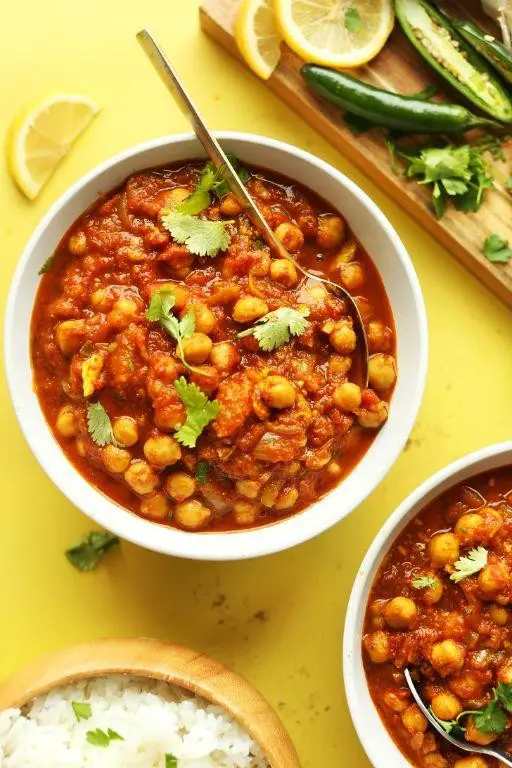
Amidst the quiet of the morning, with the sun just beginning to stretch its golden fingers across the sky, I find myself drawn to the comforting embrace of Chana Masala. This dish, with its rich tapestry of flavors and spices, feels like a warm hug on a chilly day, a reminder of the simple joys that cooking can bring.
Ingredients
- 2 cups dried chickpeas, soaked overnight (I find the texture so much better than canned)
- 1 large onion, finely chopped (yellow onions are my go-to for their sweetness)
- 3 cloves garlic, minced (because fresh is always best)
- 1 tbsp ginger, grated (it adds such a bright, spicy note)
- 2 tbsp olive oil (extra virgin, for its fruity depth)
- 1 tsp cumin seeds (they toast beautifully, releasing an earthy aroma)
- 1 tsp turmeric powder (for that golden hue and subtle bitterness)
- 1 tsp garam masala (the heart of the dish, really)
- 1 can (14.5 oz) diced tomatoes (I like the slight acidity they bring)
- Salt, to taste (sea salt flakes dissolve so evenly)
- Fresh cilantro, chopped (for that final, fresh burst of flavor)
Instructions
- Drain the soaked chickpeas and rinse them under cold water. Tip: This helps remove any residual soaking impurities.
- In a large pot, heat the olive oil over medium heat. Add the cumin seeds and toast until they start to pop, about 30 seconds. Tip: Toasting the seeds unlocks their full flavor.
- Add the chopped onion to the pot and sauté until translucent, about 5 minutes. Stir in the garlic and ginger, cooking for another minute until fragrant.
- Sprinkle in the turmeric and garam masala, stirring quickly to coat the onions and prevent the spices from burning, about 30 seconds.
- Pour in the diced tomatoes with their juices and bring the mixture to a simmer. Let it cook for about 5 minutes, allowing the flavors to meld.
- Add the drained chickpeas to the pot, along with enough water to just cover them. Bring to a boil, then reduce the heat to low, cover, and simmer for 1 hour, or until the chickpeas are tender. Tip: Check occasionally and add more water if needed to prevent drying out.
- Once the chickpeas are cooked, season with salt to taste. Stir in the fresh cilantro just before serving.
Chana Masala, with its creamy chickpeas and vibrant sauce, is a dish that sings with flavor. Serve it over a bed of fluffy basmati rice or with warm, buttery naan for a meal that feels both nourishing and indulgent.
Palak Paneer
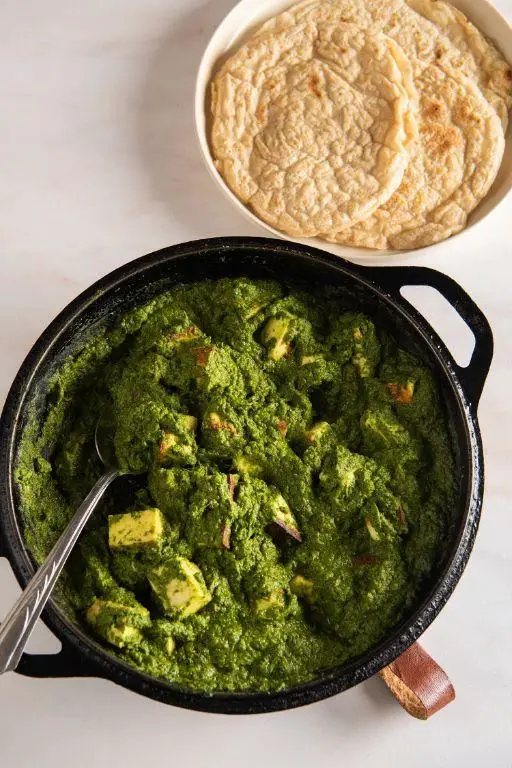
Evenings like these call for something comforting, a dish that wraps you in its warmth without weighing you down. Palak Paneer, with its vibrant greens and soft cheese cubes, is just that—a gentle hug in a bowl.
Ingredients
- 2 cups fresh spinach, tightly packed (I love the brightness it brings, almost like a whisper of spring)
- 1 cup paneer, cubed (homemade or store-bought, but always pat them dry for that perfect sear)
- 2 tbsp ghee (my kitchen smells like heaven when it melts)
- 1 medium onion, finely chopped (the sweetness balances the greens so well)
- 2 garlic cloves, minced (because what’s cooking without garlic?)
- 1 tsp cumin seeds (their nutty aroma is the first sign something delicious is coming)
- 1 tsp garam masala (the soul of the dish, really)
- 1/2 cup heavy cream (for that luxurious finish)
- Salt to taste (I start with a pinch and adjust as the flavors develop)
Instructions
- Heat 1 tbsp ghee in a pan over medium heat. Add the paneer cubes and sear until golden on all sides, about 2 minutes per side. Remove and set aside.
- In the same pan, add the remaining ghee. Toss in the cumin seeds and wait until they sizzle, about 30 seconds.
- Add the chopped onion and sauté until translucent, around 5 minutes. Stir in the garlic and cook for another minute until fragrant.
- Blanch the spinach in boiling water for 2 minutes, then plunge into ice water. Drain and blend into a smooth paste.
- Pour the spinach paste into the pan with the onions. Stir in the garam masala and salt, cooking for 5 minutes to let the flavors meld.
- Lower the heat and add the heavy cream, stirring gently to combine. Tip: The cream should just warm through; boiling can cause it to split.
- Gently fold in the seared paneer cubes, heating them through for about 2 minutes. Tip: Letting the paneer sit in the sauce for a few minutes before serving enhances its flavor.
- Serve hot. Tip: A sprinkle of fresh cream on top adds a lovely contrast to the deep green.
On the plate, the Palak Paneer is a study in contrasts—the creamy sauce clinging to the paneer, the slight bite of the greens against the soft cheese. It’s wonderful with a side of fluffy basmati rice or warm naan for scooping up every last bit.
Dal Tadka
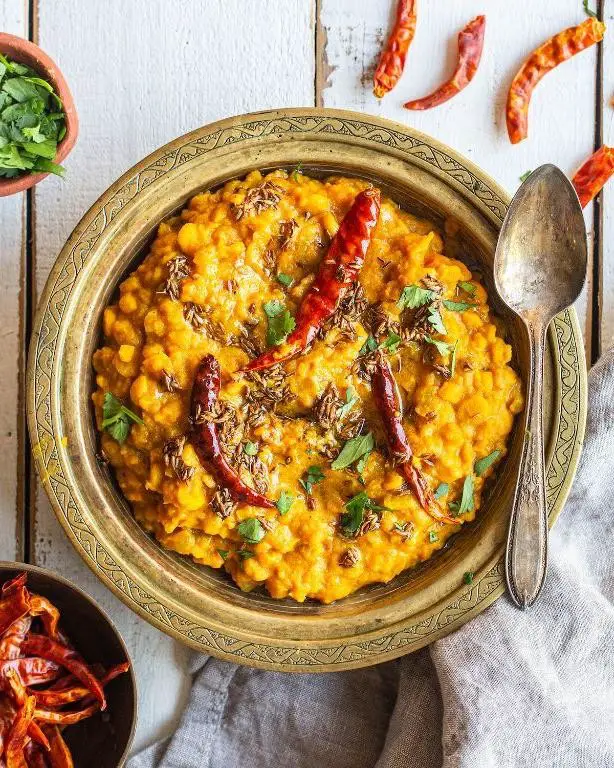
Evenings like these call for something comforting, a dish that wraps you in warmth with every spoonful. Dal Tadka, with its golden hue and aromatic spices, is just that—a humble yet profound bowl of lentils that feels like a hug.
Ingredients
- 1 cup yellow lentils (toor dal), rinsed until the water runs clear—I find this step meditative, watching the cloudy water turn transparent.
- 3 cups water, because the right amount makes the dal perfectly soupy, not too thick.
- 2 tbsp ghee, my kitchen’s favorite aroma booster.
- 1 tsp cumin seeds, for that first sizzle in the pan that signals the start of something good.
- 1 medium onion, finely chopped—I like mine golden, not brown, for a subtle sweetness.
- 2 cloves garlic, minced, because no dish is complete without its pungent kick.
- 1 tsp turmeric powder, for color and earthiness.
- 1 tsp red chili powder, adjusting this is how I control the heat for my family.
- Salt, to taste, though I usually start with 1 tsp and adjust.
- A handful of fresh cilantro, chopped, for that final burst of freshness.
Instructions
- In a pressure cooker, combine the rinsed lentils and water. Cook on high until the first whistle, then reduce to low for 3 more whistles. Let the pressure release naturally. Tip: This ensures the lentils are perfectly tender without turning mushy.
- Heat ghee in a pan over medium heat. Add cumin seeds and wait until they sizzle—about 30 seconds. Tip: The sizzle is your cue that the ghee is hot enough.
- Add the chopped onion and sauté until golden, about 5 minutes. Stir in the garlic and cook for another minute until fragrant.
- Mix in turmeric and red chili powder, stirring quickly to prevent burning. Tip: Adding a splash of water here can help the spices cook evenly without sticking.
- Pour the cooked lentils into the pan, add salt, and simmer for 10 minutes, allowing the flavors to meld. The dal should thicken slightly but remain pourable.
- Garnish with fresh cilantro before serving.
Now, the dal tadka is ready, its texture velvety with whole lentils that offer a slight bite. The flavor is a beautiful balance of earthy lentils and vibrant spices, best enjoyed with steamed rice or a slice of crusty bread for dipping. Never underestimate the power of a simple dish to bring comfort to the table.
Vegetable Biryani
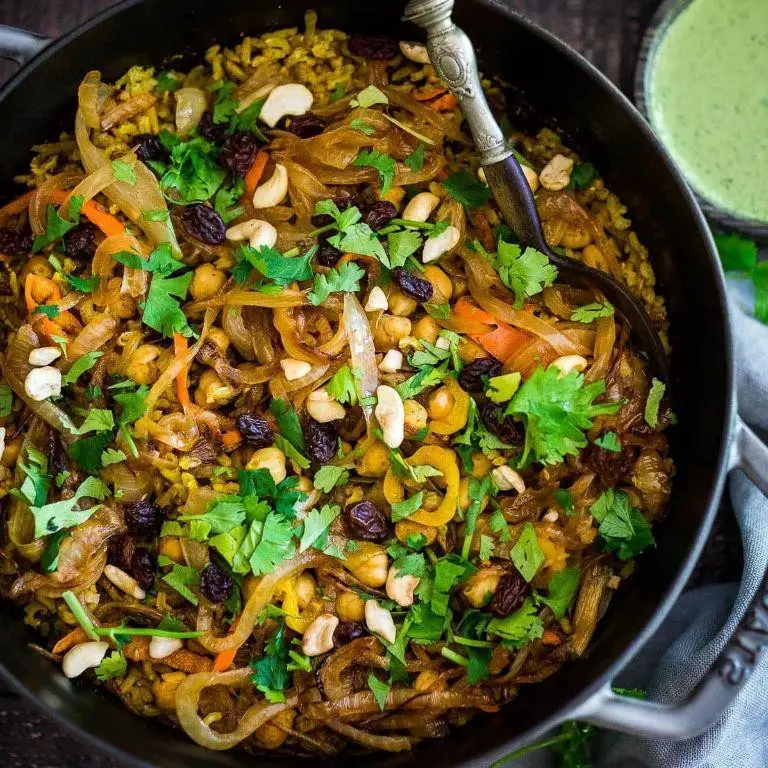
Wandering through the spices in my kitchen, I found myself drawn to the comforting aroma of basmati rice and fresh vegetables, a simple yet profound reminder of the joy found in preparing a vegetable biryani. It’s a dish that carries the warmth of home, each grain of rice telling a story of flavors melded together in harmony.
Ingredients
- 2 cups basmati rice – I always rinse mine until the water runs clear, a little ritual that feels almost meditative.
- 1 cup mixed vegetables (carrots, peas, bell peppers) – frozen works in a pinch, but fresh brings a brighter crunch.
- 1 tbsp ghee – the soul of the dish, really, though olive oil can whisper a different but equally lovely story.
- 1 tsp cumin seeds – they pop and sizzle, a signal that the magic is beginning.
- 1/2 tsp turmeric – for that golden hue that promises warmth.
- 1/2 tsp garam masala – my secret handshake with the dish, added just at the end.
- 3 cups water – the amount might seem precise, but it’s the key to perfectly fluffy rice.
- Salt to taste – though I find a scant teaspoon is just right for my palate.
Instructions
- Rinse the basmati rice under cold water until the water runs clear, then soak it for 20 minutes. This step is crucial for removing excess starch and ensuring each grain cooks separately.
- In a large pot, heat the ghee over medium heat until melted. Tip: The ghee should be warm but not smoking, a gentle heat coaxes out the best flavors.
- Add the cumin seeds to the ghee and wait for them to sizzle and pop, about 30 seconds. This releases their earthy aroma, a foundational note in the dish.
- Stir in the mixed vegetables and sauté for 2 minutes, just until they start to soften but still retain their vibrant colors.
- Drain the soaked rice and add it to the pot, gently stirring to coat each grain with the ghee and spices. Tip: Be gentle to avoid breaking the delicate grains.
- Pour in the water and add the turmeric and salt. Bring the mixture to a boil, then reduce the heat to low, cover, and simmer for 15 minutes. Tip: Resist the urge to peek; the steam needs to work its magic undisturbed.
- After 15 minutes, turn off the heat and let the pot sit, covered, for another 5 minutes. Then, sprinkle the garam masala over the top and fluff the rice with a fork.
Delving into the biryani, the first thing you’ll notice is how each grain of rice stands apart, yet together they create a tapestry of flavors. The vegetables add a sweet crunch, a contrast to the soft, fragrant rice. Serve it with a dollop of yogurt on the side, or for a bit of drama, garnish with fried onions and fresh cilantro leaves.
Aloo Gobi
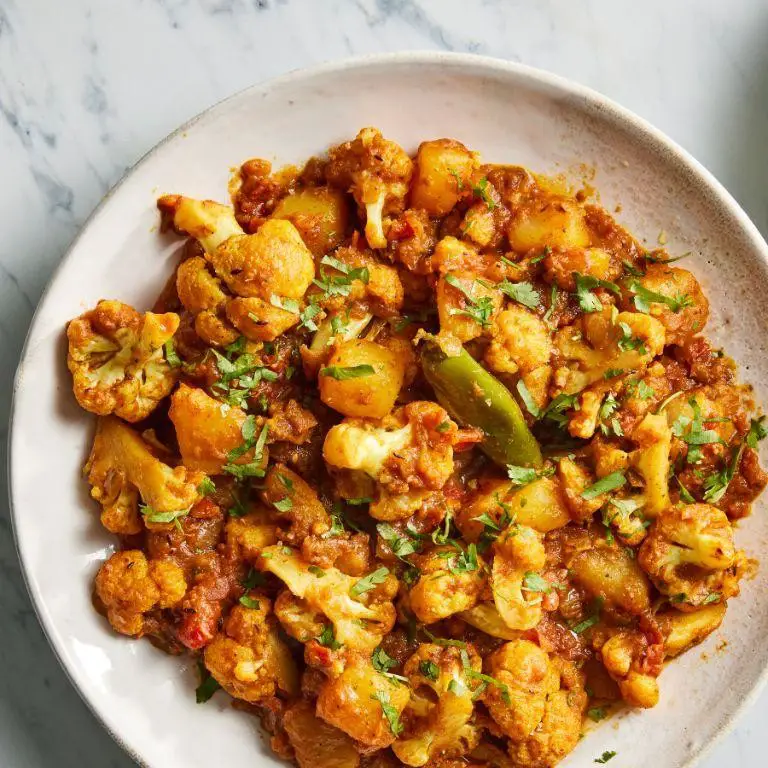
Musing over the simplicity and warmth of home-cooked meals, Aloo Gobi stands out as a comforting embrace of spices and textures. This dish, with its humble beginnings, has a way of turning ordinary ingredients into a symphony of flavors that linger lovingly on the palate.
Ingredients
- 2 tablespoons extra virgin olive oil (my go-to for its fruity notes)
- 1 large onion, finely chopped (I find yellow onions add a subtle sweetness)
- 2 cloves garlic, minced (freshly minced garlic brings a vibrant punch)
- 1 tablespoon ginger, grated (keep your ginger in the freezer for easier grating)
- 1 teaspoon cumin seeds (toasting them slightly before use unlocks their aroma)
- 1 teaspoon turmeric powder (for that golden hue and earthy flavor)
- 1 teaspoon coriander powder (a staple in my spice drawer)
- 2 medium potatoes, cubed (I prefer Yukon Gold for their buttery texture)
- 1 small cauliflower, cut into florets (look for tight, creamy white heads)
- Salt to taste (I start with 1/2 teaspoon and adjust as needed)
- Fresh cilantro, chopped (a generous handful for garnish and freshness)
Instructions
- Heat the olive oil in a large skillet over medium heat until shimmering, about 2 minutes.
- Add the cumin seeds and toast for 30 seconds, until fragrant, stirring constantly to prevent burning.
- Stir in the onion, garlic, and ginger, cooking until the onion is translucent, about 5 minutes.
- Sprinkle in the turmeric and coriander powder, stirring for 1 minute to coat the onions evenly.
- Add the potatoes and cauliflower, tossing gently to mix with the spices. Tip: Cut the potatoes and cauliflower into similar sizes for even cooking.
- Cover and cook on low heat for 20 minutes, stirring occasionally, until the vegetables are tender. Tip: If the mixture sticks, add a tablespoon of water to loosen.
- Season with salt, adjusting as needed, and garnish with fresh cilantro before serving. Tip: Let the dish sit for 5 minutes off the heat to allow the flavors to meld.
Offering a delightful contrast between the soft potatoes and the slightly crisp cauliflower, this Aloo Gobi is a testament to the beauty of simple ingredients. Serve it alongside warm rotis or over a bed of basmati rice for a meal that feels like a hug.
Pav Bhaji
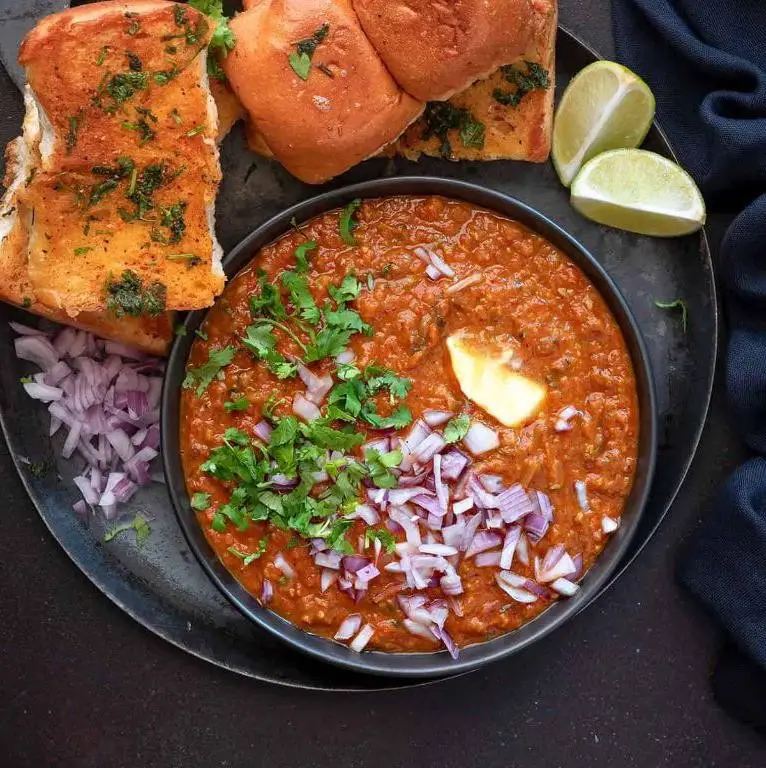
Lately, I’ve found myself drawn to the comforting embrace of Pav Bhaji, a dish that feels like a warm hug on a chilly evening. Its vibrant colors and rich flavors tell a story of bustling streets and shared meals, a reminder of the joy found in simplicity.
Ingredients
- 2 cups mashed potatoes (I find Yukon Golds work best for their buttery texture)
- 1 cup chopped tomatoes (ripe, juicy ones make all the difference)
- 1/2 cup green peas (frozen works fine, but fresh peas in season are a delight)
- 1/4 cup butter (unsalted, because I like to control the saltiness)
- 2 tbsp Pav Bhaji masala (this spice blend is the soul of the dish)
- 1 tbsp ginger-garlic paste (homemade if possible, for that extra punch)
- 1/2 cup chopped onions (red onions add a nice sweetness)
- 1 tbsp lemon juice (freshly squeezed, to brighten up the flavors)
- 4 pav buns (lightly toasted with butter, they’re the perfect vessel)
Instructions
- Melt 2 tbsp butter in a large pan over medium heat (about 300°F), adding a bit more if the pan feels dry.
- Add the chopped onions, cooking until translucent (about 5 minutes), stirring occasionally to prevent burning.
- Stir in the ginger-garlic paste, cooking for another minute until the raw smell disappears.
- Add the chopped tomatoes, cooking until they soften and release their juices (about 5 minutes).
- Sprinkle in the Pav Bhaji masala, mixing well to coat the tomatoes and onions evenly.
- Fold in the mashed potatoes and green peas, adding a splash of water if the mixture seems too thick.
- Let the bhaji simmer on low heat for 10 minutes, stirring occasionally to prevent sticking.
- Finish with a drizzle of lemon juice and the remaining butter, stirring until fully incorporated.
- Serve hot with buttered pav buns, garnished with chopped onions and a wedge of lemon on the side.
Now, the bhaji should be rich and hearty, with a melody of spices that dance on the palate. Try serving it with a side of pickled onions for an extra crunch, or a dollop of yogurt to cool the spices. Never underestimate the power of a simple dish to bring people together, and Pav Bhaji does just that, with every bite a celebration of flavors.
Samosa
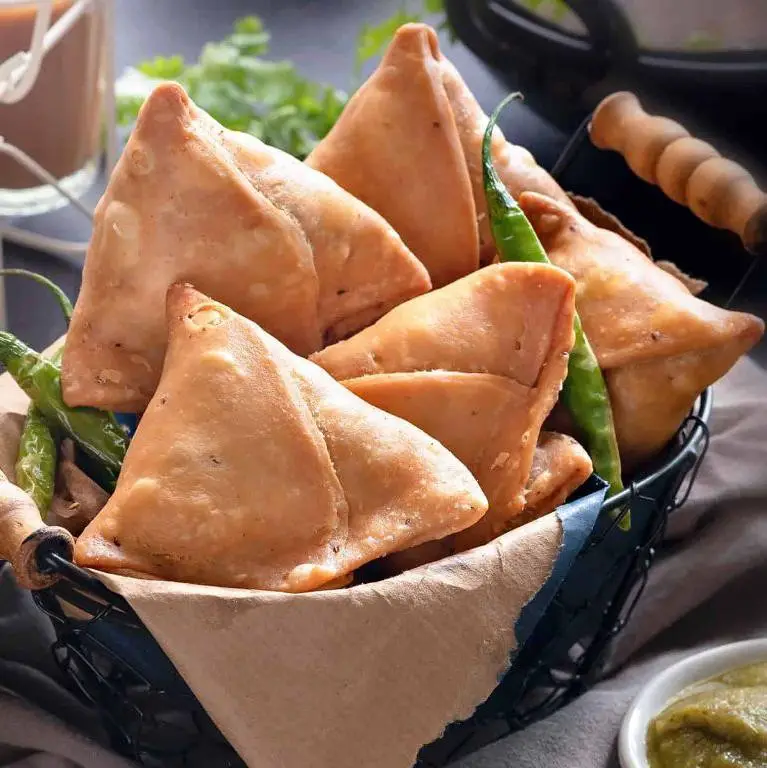
On a quiet evening like this, the thought of samosas brings a warmth to my heart, their crispy exterior giving way to a spiced, comforting filling that feels like a hug from within.
Ingredients
- 2 cups all-purpose flour (I find the brand matters here; King Arthur never lets me down)
- 1/4 cup vegetable oil (extra virgin olive oil adds a nice depth, but any neutral oil works)
- 1/2 tsp salt (sea salt for that subtle crunch)
- 1/2 cup water (room temperature, to help the dough come together smoothly)
- 2 large potatoes, boiled and diced (Yukon Golds are my go-to for their buttery texture)
- 1/2 cup peas (frozen works just fine, but fresh peas in season are a delight)
- 1 tbsp cumin seeds (toasting them lightly before use unlocks their aroma)
- 1 tsp garam masala (homemade if you have it, but store-bought is perfectly fine)
- 1/2 tsp turmeric (for that golden hue and earthy flavor)
- Oil for frying (enough to deep fry, about 2 cups)
Instructions
- In a large bowl, mix the all-purpose flour, vegetable oil, and salt until the mixture resembles coarse crumbs.
- Gradually add water, kneading until a smooth dough forms. Cover with a damp cloth and let it rest for 30 minutes. Tip: The resting time is crucial for a pliable dough.
- Heat a pan over medium heat and toast the cumin seeds until fragrant, about 30 seconds.
- Add the diced potatoes, peas, garam masala, and turmeric to the pan. Cook for 5 minutes, stirring occasionally, until everything is well combined. Tip: Taste and adjust the seasoning now, as it’s harder to do once the samosas are assembled.
- Divide the dough into equal portions and roll each into a thin circle. Cut each circle in half.
- Form a cone with each half-circle, fill with the potato mixture, and seal the edges with a little water. Tip: Ensure the edges are well sealed to prevent the filling from leaking during frying.
- Heat the oil in a deep pan to 350°F. Fry the samosas in batches until golden brown, about 3-4 minutes per side. Drain on paper towels.
When you bite into these samosas, the contrast between the crispy shell and the soft, spiced filling is nothing short of magical. Serve them with a side of tangy tamarind chutney or a cooling mint yogurt sauce for a delightful play of flavors.
Masala Dosa
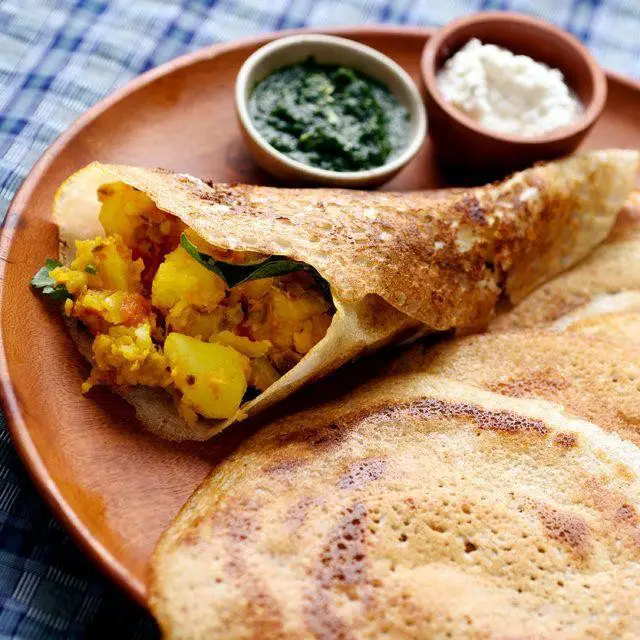
Just imagine the crisp sound of a golden-brown crepe meeting your plate, a symphony of spices waiting to unfold. Masala dosa, a beloved South Indian delicacy, is not just food; it’s a morning ritual, a comfort, a story on a plate.
Ingredients
- 2 cups rice flour (I find the fine texture makes for a smoother batter)
- 1/2 cup urad dal flour (for that essential lightness)
- 1/4 tsp fenugreek seeds (they add a subtle bitterness that balances the flavors)
- 1 cup warm water (around 110°F, just right to activate the fermentation)
- 1/2 tsp salt (I like to use sea salt for its mineral touch)
- 2 tbsp vegetable oil (a neutral oil works best here)
- 1 large potato, boiled and mashed (the heart of the filling, creamy and comforting)
- 1/2 tsp mustard seeds (they pop beautifully, releasing their aroma)
- 1 dried red chili (for a gentle heat that lingers)
- 1/4 tsp turmeric powder (a pinch for color and health)
- 1 small onion, finely chopped (I prefer them slightly caramelized)
Instructions
- In a large bowl, combine rice flour, urad dal flour, fenugreek seeds, and salt. Gradually add warm water, whisking to avoid lumps, until the batter is smooth. Cover and let it ferment overnight in a warm place (around 85°F). Tip: The batter should double in size, indicating good fermentation.
- Heat a non-stick skillet over medium heat (350°F). Pour a ladleful of batter in the center, spreading it outward in a circular motion to form a thin crepe. Drizzle 1/2 tsp oil around the edges. Cook until the bottom is golden and crisp, about 2 minutes. Tip: Wait for the edges to lift slightly before flipping.
- For the filling, heat 1 tbsp oil in a pan. Add mustard seeds and dried red chili, sautéing until the seeds pop. Add onions and turmeric, cooking until soft. Stir in mashed potato, mixing well. Season with salt to taste.
- Place a portion of the potato filling on one half of the dosa. Fold the other half over the filling. Serve hot. Tip: A dollop of coconut chutney on the side elevates the dish.
Soft yet crisp, the dosa encases a spiced potato filling that’s both hearty and delicate. Try serving it with a side of tangy tomato chutney for a contrast that dances on the palate.
Rogan Josh
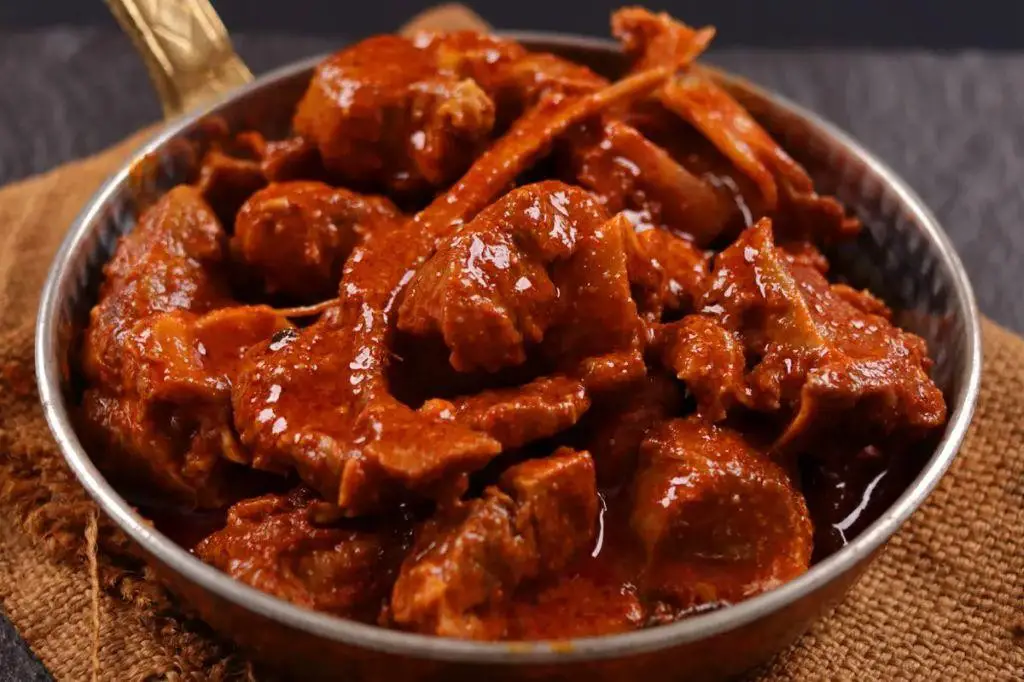
Under the soft glow of the kitchen light, the rich aroma of Rogan Josh fills the air, a dish that carries the warmth of Kashmir into our homes, blending spices and tenderness in a dance of flavors.
Ingredients
- 2 lbs lamb shoulder, cut into 2-inch pieces (the marbling here is key for tenderness)
- 1/4 cup extra virgin olive oil (my go-to for its fruity notes)
- 2 large onions, finely sliced (they melt into the sauce, sweetening it beautifully)
- 4 garlic cloves, minced (freshly minced releases the best aroma)
- 1 tbsp ginger paste (I keep a jar in the fridge for convenience)
- 2 tsp ground cumin (toasting the seeds and grinding them fresh makes a difference)
- 2 tsp ground coriander
- 1 tsp turmeric
- 1 tsp cayenne pepper (adjust based on your heat preference)
- 1 cup plain yogurt, room temperature (helps in tenderizing the meat)
- 2 cups water (for the perfect gravy consistency)
- Salt, to taste (I start with 1 tsp and adjust later)
Instructions
- Heat the olive oil in a heavy-bottomed pot over medium heat until shimmering.
- Add the sliced onions and cook, stirring occasionally, until golden brown, about 10 minutes.
- Stir in the minced garlic and ginger paste, cooking for another 2 minutes until fragrant.
- Add the lamb pieces, browning them on all sides, about 5 minutes total.
- Sprinkle the ground cumin, coriander, turmeric, and cayenne pepper over the meat, stirring well to coat.
- Lower the heat to medium-low and add the yogurt, stirring continuously to prevent curdling.
- Pour in the water, bring to a simmer, then cover and cook on low heat for 1.5 hours, until the lamb is tender.
- Season with salt, then uncover and cook for an additional 10 minutes to thicken the sauce.
Perfectly tender lamb bathed in a velvety, spiced gravy, Rogan Josh is a dish that invites you to savor each bite. Serve it over a bed of steamed basmati rice or with warm naan to soak up every last drop of its rich sauce.
Malai Kofta
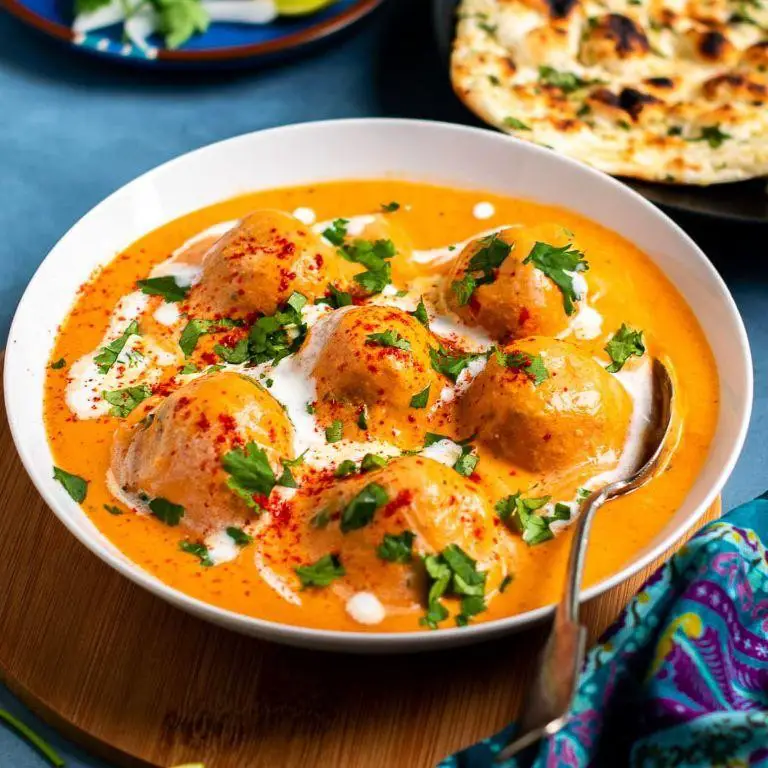
Kindly imagine a dish that wraps you in its creamy embrace, a dish where each bite feels like a gentle whisper of spices and warmth—Malai Kofta is just that. It’s a luxurious vegetarian delight that turns simple ingredients into a symphony of flavors, perfect for those evenings when you crave something indulgent yet comforting.
Ingredients
- 2 cups paneer, grated (I find the homemade version adds a special touch)
- 1/2 cup heavy cream (for that irresistible richness)
- 1 tbsp ghee (my grandmother’s secret to depth of flavor)
- 1 tsp garam masala (the heart of the dish)
- 1/2 cup all-purpose flour (for binding, though chickpea flour works wonders too)
- 2 cups tomato puree (I like mine slightly tangy)
- 1 tbsp sugar (just a hint to balance the acidity)
- 1/2 tsp turmeric (for that golden hue)
- 1/2 cup water (to adjust the gravy’s consistency)
Instructions
- In a large bowl, mix the grated paneer, 1/4 cup heavy cream, and garam masala until well combined. Tip: The mixture should hold together when pressed; if not, a little flour can help.
- Shape the mixture into small balls, about the size of a walnut, and lightly coat them in all-purpose flour.
- Heat ghee in a pan over medium heat (350°F) and fry the koftas until golden brown, about 2-3 minutes per side. Tip: Don’t overcrowd the pan to ensure even cooking.
- In the same pan, add tomato puree, sugar, and turmeric. Cook for 5 minutes until the oil starts to separate. Tip: This is when the flavors truly meld together.
- Slowly stir in the remaining heavy cream and water, bringing the gravy to a gentle simmer.
- Add the fried koftas to the gravy, cover, and let them soak in the flavors for 10 minutes on low heat.
Finally, the Malai Kofta is ready to enchant. The koftas are melt-in-your-mouth tender, floating in a velvety gravy that’s a perfect balance of sweet and spicy. Serve it with a sprinkle of fresh cilantro or a side of fluffy naan to scoop up every last bit of goodness.
Pani Puri
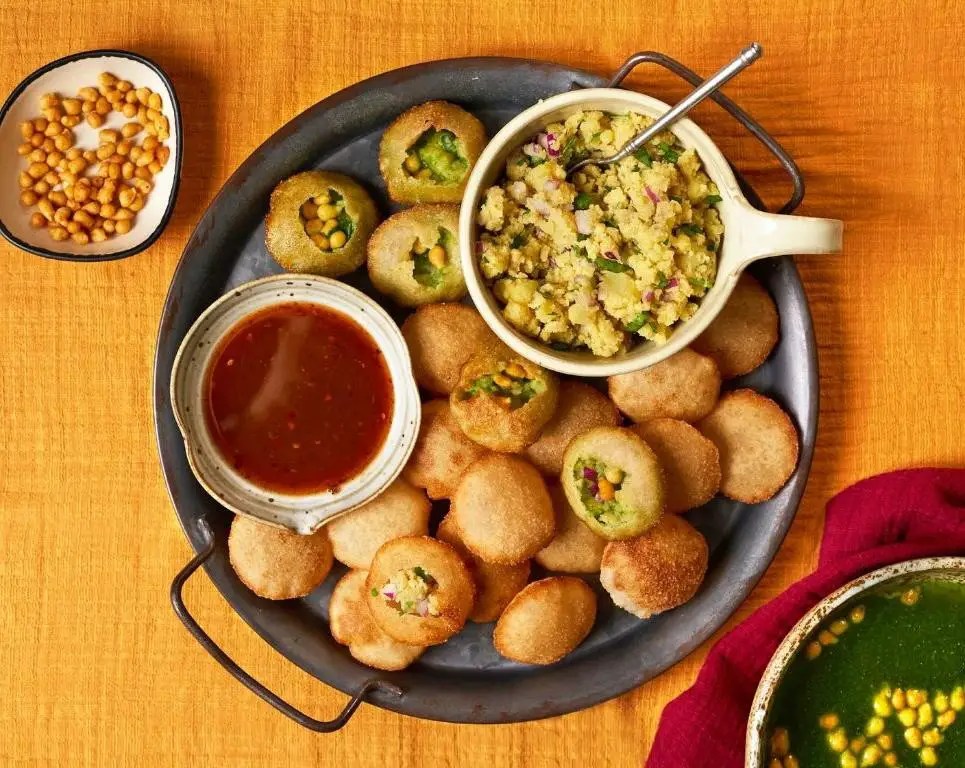
Under the soft glow of the kitchen light, there’s something deeply comforting about assembling pani puri, a dish that dances between crisp and tender, spicy and sweet, in every bite.
Ingredients
- 1 cup semolina flour (I find Bob’s Red Mill gives the perfect texture)
- 1/2 cup water (lukewarm, to help the dough come together smoothly)
- 1/4 tsp baking soda (a tiny pinch works wonders for puffing)
- 1 tsp salt (I like Himalayan pink for its subtle minerality)
- 1 quart vegetable oil for frying (peanut oil is my choice for its high smoke point)
- 1 cup boiled chickpeas (canned works, but I prefer the texture of home-cooked)
- 1/2 cup tamarind chutney (store-bought is fine, but homemade sings)
- 1/4 cup mint-cilantro water (I blend mine with a touch of green chili for heat)
- 1/2 cup diced potatoes (Yukon Golds hold their shape nicely)
- 1/4 cup finely chopped onions (red onions add a nice color pop)
Instructions
- In a large bowl, mix semolina flour, baking soda, and salt. Gradually add lukewarm water, kneading until a firm dough forms. Cover with a damp cloth and let rest for 30 minutes.
- Divide the dough into small, equal portions. Roll each into a smooth ball, then flatten into thin discs, about 2 inches in diameter.
- Heat peanut oil in a deep fryer or heavy-bottomed pot to 375°F. Fry the discs in batches until they puff up and turn golden brown, about 2 minutes per batch. Drain on paper towels.
- Once cooled, gently crack open the top of each puri to create a small hole. Fill each with a spoonful of chickpeas, potatoes, and onions.
- Drizzle tamarind chutney and mint-cilantro water into each puri, ensuring the flavors meld beautifully inside.
Lightly crisp shells give way to a burst of flavors and textures, making each pani puri a tiny celebration. Serve them immediately, arranged on a platter with extra chutney and spiced water on the side for those who dare to dive deeper into the spice.
Bhel Puri
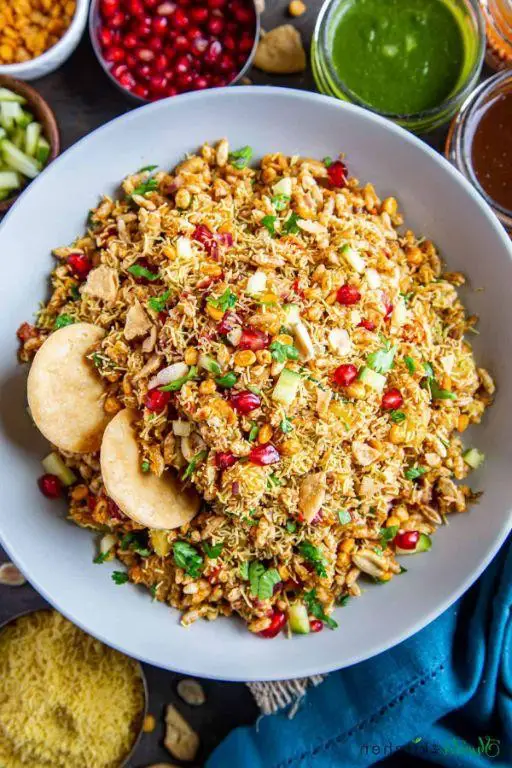
Evenings like these remind me of the bustling streets of Mumbai, where the air is filled with the irresistible aroma of street food, and among them, Bhel Puri stands out as a delightful symphony of flavors and textures.
Ingredients
- 2 cups puffed rice (I love the light, airy texture it brings to the dish)
- 1/2 cup sev (those crispy chickpea flour noodles add a wonderful crunch)
- 1/4 cup finely chopped onions (I prefer red onions for their mild sweetness)
- 1/4 cup chopped tomatoes (ripe and juicy ones work best)
- 2 tbsp tamarind chutney (homemade or store-bought, it’s the soul of the dish)
- 2 tbsp green chutney (I like mine with a bit of extra mint for freshness)
- 1 tbsp lemon juice (freshly squeezed, it brightens up the flavors)
- 1/2 tsp chaat masala (this spice blend is magical, don’t skip it)
- 1/4 cup chopped cilantro (for that final touch of green)
Instructions
- In a large mixing bowl, combine the puffed rice and sev. Gently toss them together to mix evenly.
- Add the chopped onions and tomatoes to the bowl. The key here is to keep the pieces small for a perfect bite every time.
- Drizzle the tamarind and green chutney over the mixture. I like to start with less and add more as needed, ensuring the dish doesn’t get soggy.
- Squeeze the lemon juice evenly over the top, then sprinkle the chaat masala. This is when the flavors start to come alive.
- Give everything a gentle toss, making sure all the ingredients are well coated with the chutneys and spices. Tip: Use your hands for mixing to feel the textures and adjust seasoning.
- Finally, garnish with chopped cilantro. It adds a fresh contrast to the tangy and spicy flavors.
- Serve immediately to enjoy the crispness of the puffed rice and sev. Tip: For an extra crunch, add a handful of roasted peanuts.
Crunchy, tangy, and slightly spicy, this Bhel Puri is a feast for the senses. I love serving it in small paper cones for an authentic street food experience at home.
Kheer
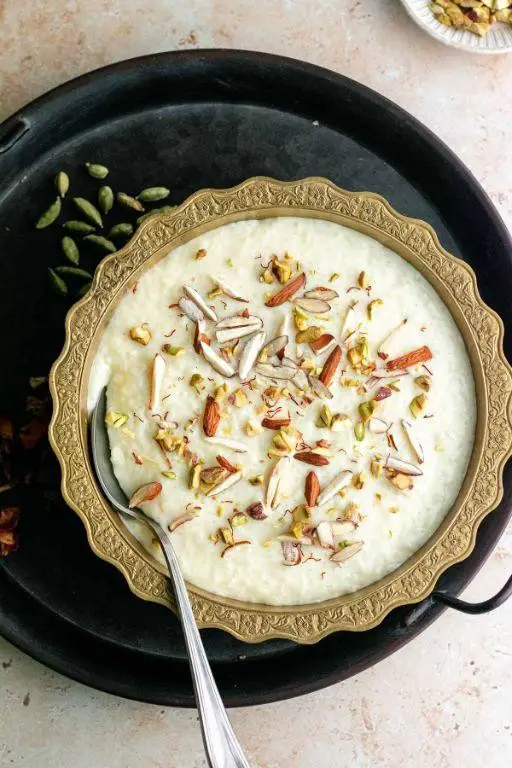
Fragrant and comforting, kheer is a dish that whispers of home and tradition, a creamy rice pudding that’s as much about the memories it evokes as the flavors it delivers. It’s a simple pleasure, yet each spoonful carries the warmth of shared stories and quiet moments.
Ingredients
- 1/2 cup basmati rice – I find the long grains add a lovely texture, soaking up the milk just right.
- 4 cups whole milk – There’s no substitute for the richness it brings.
- 1/2 cup sugar – Adjust this if you like your desserts less sweet, but this is my sweet spot.
- 1/4 tsp cardamom powder – A whisper of spice that makes all the difference.
- 2 tbsp chopped nuts (almonds and pistachios) – For that crunch and a pop of color.
- A pinch of saffron – Soaked in a tbsp of warm milk, it’s like liquid gold.
- 1 tbsp ghee – Because everything’s better with a little ghee.
Instructions
- Rinse the basmati rice under cold water until the water runs clear, then soak it in water for 30 minutes. This step ensures the rice cooks evenly.
- In a heavy-bottomed pan, heat the ghee over medium heat and add the drained rice. Stir gently for 2 minutes, toasting the rice lightly.
- Pour in the milk and bring to a gentle boil, then reduce the heat to low. Stir occasionally to prevent the rice from sticking to the bottom.
- Simmer for 25 minutes, or until the rice is tender and the milk has thickened significantly. The key here is patience; the slow cooking melds the flavors beautifully.
- Add the sugar, cardamom powder, and saffron-soaked milk. Stir well and cook for another 5 minutes. The sugar should dissolve completely.
- Turn off the heat and let the kheer sit for 10 minutes. It will thicken a bit more as it cools.
- Garnish with chopped nuts before serving. The contrast of the creamy pudding and the crunchy nuts is divine.
Unassuming yet unforgettable, this kheer is a tapestry of textures and tastes, with the creamy rice playing off the crunchy nuts and the aromatic cardamom. Serve it chilled on a hot day or warm when the evenings are cool, and watch as it becomes more than just a dessert.
Gulab Jamun
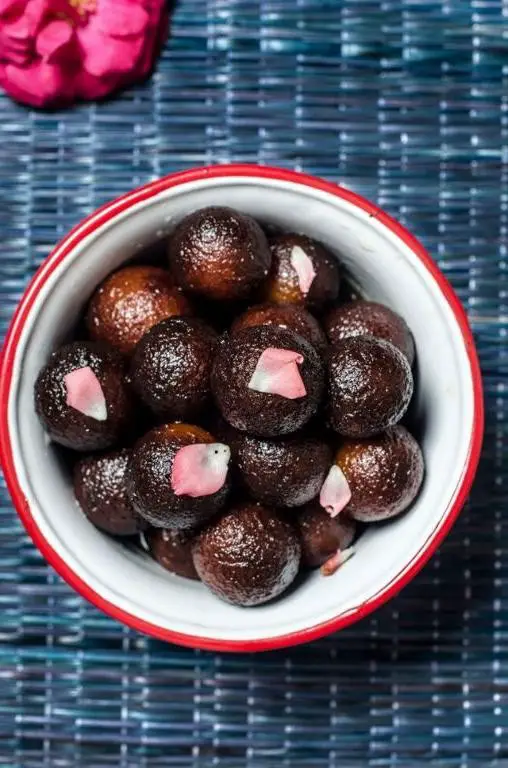
Lately, I’ve found myself drawn to the comforting embrace of Gulab Jamun, a dessert that feels like a warm hug on a chilly evening. Its soft, syrup-soaked balls carry the essence of celebration and the simplicity of home.
Ingredients
- 1 cup milk powder (I swear by the richness of full-fat milk powder for that melt-in-the-mouth texture.)
- 1/4 cup all-purpose flour (A little goes a long way in binding the dough.)
- 1/8 tsp baking soda (Just a pinch to lift the dough ever so slightly.)
- 2 tbsp ghee, melted (The soul of the dough, ghee adds an irreplaceable aroma.)
- 1/4 cup milk, room temperature (Cold milk can make the dough tough, so I always let it sit out for a bit.)
- 1 cup sugar (For the syrup, because life is sweet.)
- 1 cup water (To dissolve the sugar into a luscious syrup.)
- 2 cardamom pods, crushed (A whisper of spice to elevate the syrup.)
- Oil for deep frying (I prefer a neutral oil like sunflower for a clean taste.)
Instructions
- In a mixing bowl, combine milk powder, all-purpose flour, and baking soda. Sift them together to ensure there are no lumps.
- Add melted ghee to the dry ingredients. Mix gently with your fingers until the mixture resembles breadcrumbs.
- Gradually add milk, a little at a time, kneading into a soft dough. The dough should be smooth and slightly sticky but manageable. Tip: Over-kneading can make the jamuns hard, so stop as soon as it comes together.
- Divide the dough into small portions and roll them into smooth, crack-free balls. Tip: If the dough cracks, dab a little milk on your palms to smooth it out.
- Heat oil in a deep pan over medium-low heat (around 300°F). The key is to fry them slowly for even cooking.
- Fry the balls in batches, turning occasionally, until they are a deep golden brown. This should take about 7-8 minutes per batch. Tip: Keep the heat consistent to avoid burning.
- Meanwhile, prepare the syrup by boiling sugar, water, and crushed cardamom pods until it reaches a one-string consistency (about 220°F).
- Soak the fried jamuns in the warm syrup for at least 2 hours before serving, allowing them to absorb the sweetness fully.
Yielded from this process are Gulab Jamuns that are irresistibly soft, with a syrup that seeps into every pore, offering a burst of sweetness with every bite. Serve them warm, perhaps with a scoop of vanilla ice cream, to contrast the warmth with a cool creaminess.
Jalebi
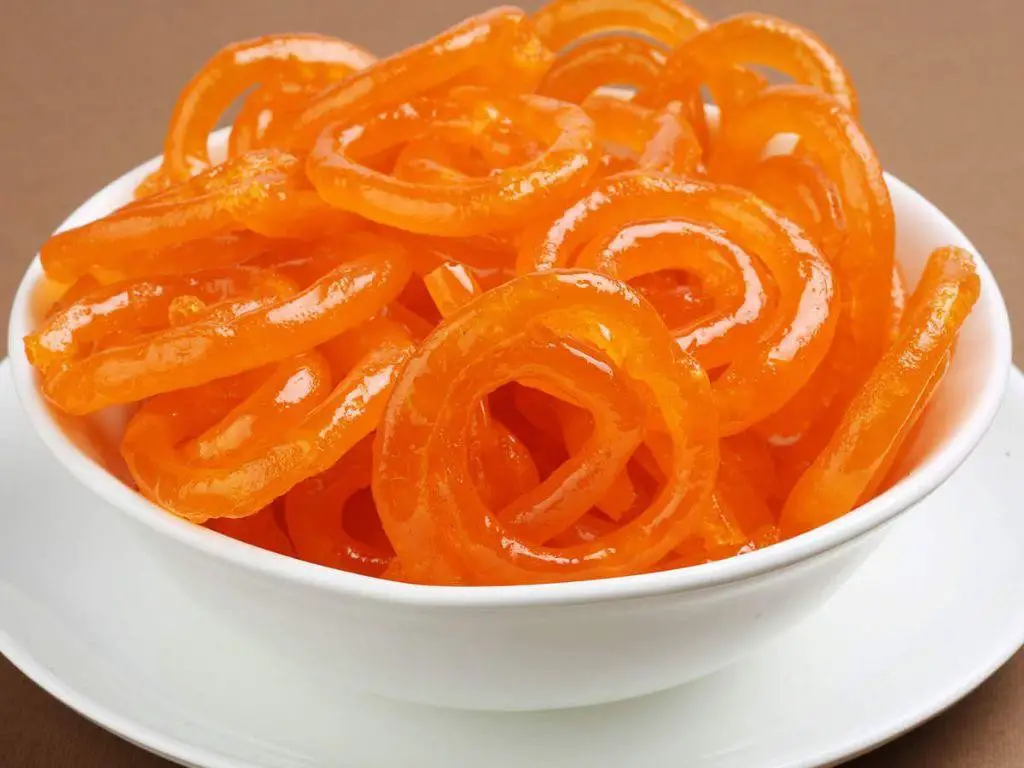
Just like the first light of dawn, Jalebi brings a sweet, golden glow to any table, its crisp edges giving way to a syrup-soaked center that whispers of saffron and cardamom.
Ingredients
- 1 cup all-purpose flour (I sift mine twice for that airy texture we all love)
- 1 tbsp cornstarch (a little secret for extra crunch)
- 1/2 cup warm water (just enough to bring the dough together)
- 1/2 tsp baking powder (the lift in every bite)
- A pinch of saffron threads (soaking them in a tbsp of warm milk unlocks their aroma)
- 1 cup sugar (for the syrup that hugs each swirl)
- 1/2 cup water (for the syrup, clarity is key)
- 1/2 tsp cardamom powder (the soul of the syrup)
- Oil for deep frying (I use sunflower oil for its neutral taste)
Instructions
- In a bowl, whisk together the all-purpose flour, cornstarch, and baking powder. Gradually add warm water until a smooth, thick batter forms. Cover and let it ferment for 8 hours or overnight. Tip: A warm spot speeds up fermentation.
- Soak saffron threads in a tablespoon of warm milk and set aside. This step is your fragrance foundation.
- For the syrup, combine sugar and water in a saucepan. Bring to a boil, then simmer for 10 minutes until slightly thickened. Stir in the cardamom powder and saffron milk. Keep warm.
- Heat oil in a deep pan to 350°F. Fill a squeeze bottle with the batter and pipe concentric circles into the hot oil. Fry until golden and crisp, about 2 minutes per side. Tip: Keep the oil temperature steady for even cooking.
- Drain the jalebis and immediately dip into the warm syrup for 30 seconds. Transfer to a wire rack to let excess syrup drip off. Tip: The syrup should be warm, not hot, to soak perfectly.
At its best, Jalebi is a dance of textures—crisp, then yielding, with a syrup that’s floral and just sweet enough. Serve it warm with a dollop of cold rabri for a contrast that’s pure magic.
Papdi Chaat
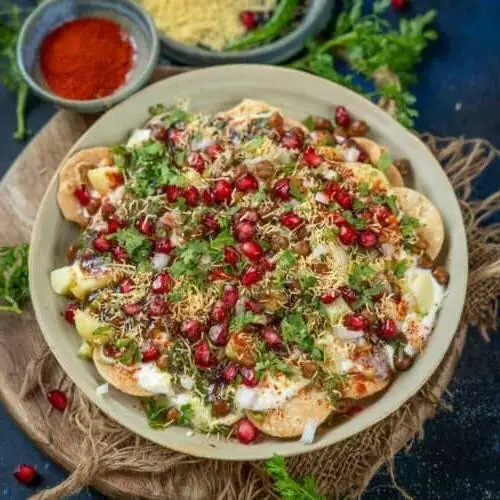
Dusk settles softly outside, and the kitchen beckons with the promise of something both comforting and vibrant. Today, I’m drawn to the idea of Papdi Chaat, a dish that dances between textures and flavors, offering a little crunch, a touch of sweetness, and a burst of tanginess in every bite.
Ingredients
- 1 cup all-purpose flour (I find that sifting it first makes for a lighter papdi)
- 1/4 cup semolina (for that perfect crispness)
- 1/2 tsp carom seeds (ajwain, they add a subtle bitterness that balances the dish)
- 1/4 cup water (room temperature, to bring the dough together gently)
- 2 tbsp ghee (melted, it enriches the dough beautifully)
- 1/2 tsp salt (just enough to enhance the flavors)
- 1 cup boiled potatoes, diced (I like them slightly chunky for texture)
- 1/2 cup yogurt (whipped until smooth, it’s the creamy counterpoint)
- 2 tbsp tamarind chutney (homemade or store-bought, its tang is essential)
- 1 tbsp mint chutney (for a fresh, herby kick)
- 1/4 tsp red chili powder (adjust to your heat preference)
- 1/4 tsp roasted cumin powder (it adds a smoky depth)
- 1/4 cup sev (for that final, irresistible crunch)
- Fresh cilantro leaves (a handful, torn, for a burst of color and freshness)
Instructions
- In a large bowl, combine the all-purpose flour, semolina, carom seeds, and salt. Mix these dry ingredients well to ensure even distribution.
- Add the melted ghee to the dry ingredients. Use your fingers to rub the ghee into the flour until the mixture resembles coarse crumbs.
- Gradually add water, a little at a time, kneading gently to form a stiff dough. Cover the dough with a damp cloth and let it rest for 15 minutes. This resting period makes the dough easier to roll.
- Divide the dough into small portions. Roll each portion into a thin circle, about 3 inches in diameter. Prick each circle with a fork to prevent puffing during frying.
- Heat oil in a deep pan over medium heat (350°F). Fry the rolled dough circles in batches until golden and crisp, about 2 minutes per side. Drain on paper towels.
- Arrange the fried papdis on a serving plate. Top each with diced potatoes, a dollop of yogurt, drizzles of tamarind and mint chutneys, a sprinkle of red chili and cumin powders, and a generous handful of sev.
- Garnish with torn cilantro leaves just before serving to keep them vibrant.
Golden and inviting, each papdi chaat is a mosaic of flavors and textures—crispy, creamy, tangy, and spicy all at once. Serve it immediately, perhaps with a side of sweet mango slices to complement the tanginess, and watch as it becomes the centerpiece of any gathering.
Dhokla
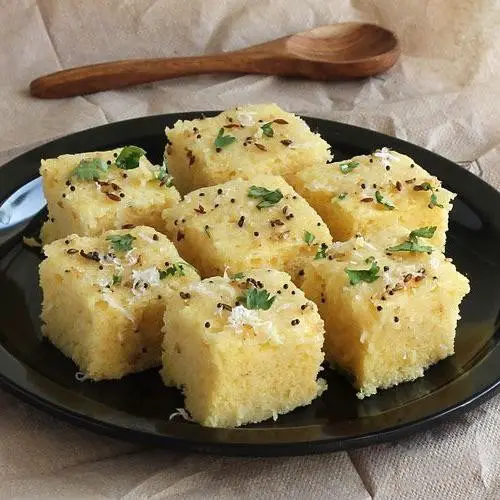
Amidst the quiet of the morning, I find myself drawn to the simplicity and warmth of Dhokla, a steamed cake that carries the essence of Gujarati cuisine. Its light, spongy texture and subtle tanginess make it a comforting start to the day or a delicate snack to savor with tea.
Ingredients
- 1 cup gram flour (besan) – I love the nutty flavor it brings, sifted to avoid lumps.
- 1 tbsp lemon juice – Freshly squeezed, it adds just the right amount of tang.
- 1 tsp ginger paste – A little goes a long way in warming up the dish.
- 1/2 tsp turmeric powder – For that golden hue and a hint of earthiness.
- 1 tsp Eno fruit salt – The magic ingredient for that perfect fluffiness.
- 1 tbsp sugar – Just enough to balance the flavors.
- 1/2 cup water – Room temperature, to blend everything smoothly.
- 1 tbsp oil – I use sunflower oil for its neutral taste.
- 1/2 tsp mustard seeds – For the tempering, they pop beautifully in hot oil.
- 2 green chilies, finely chopped – Adjust according to your heat preference.
- A handful of fresh cilantro leaves – For garnish, they add a burst of color and freshness.
Instructions
- In a large bowl, combine gram flour, lemon juice, ginger paste, turmeric powder, and sugar. Gradually add water, whisking continuously to form a smooth batter. Let it rest for 10 minutes; this helps the flavors meld.
- Grease a steaming dish with oil, ensuring it’s well-coated to prevent sticking. Tip: A well-greased dish ensures your Dhokla comes out cleanly.
- Just before steaming, add Eno fruit salt to the batter and mix gently. You’ll see bubbles forming; this is what gives Dhokla its airy texture.
- Pour the batter into the prepared dish and place it in a steamer. Steam over medium heat for 15 minutes, or until a toothpick inserted comes out clean. Tip: Keep the steam consistent for even cooking.
- While the Dhokla steams, heat oil in a small pan. Add mustard seeds and let them pop, then add green chilies for a few seconds. Tip: Tempering on low heat prevents burning.
- Once the Dhokla is done, pour the tempering over the top and garnish with cilantro leaves.
Cool the Dhokla slightly before cutting into squares. Its spongy texture and the interplay of tangy, sweet, and spicy flavors make it irresistible. Serve it with a side of mint chutney or simply enjoy it as is, letting each bite transport you to the bustling streets of Gujarat.
Conclusion
Vibrant and full of flavor, this roundup of 18 Delicious Easy Indian Recipes Spicy is your ticket to exploring the rich tastes of India from your own kitchen. Whether you’re a seasoned pro or new to Indian cuisine, these recipes promise a delightful adventure. Don’t forget to share your favorites in the comments and pin this article on Pinterest to spread the spice love!